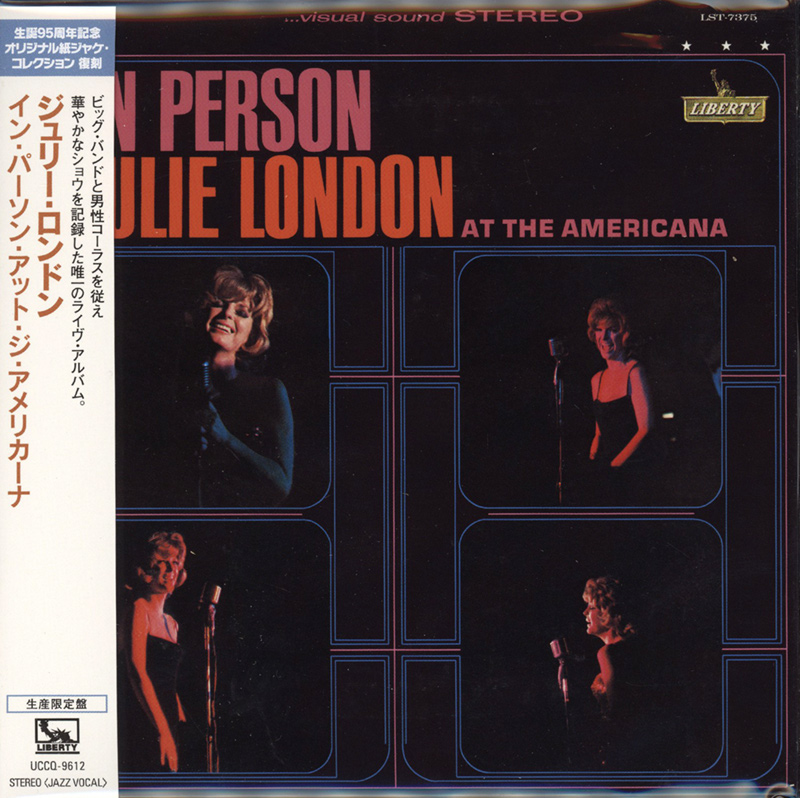Logowanie
Mikołaj - ten to ma gest!
Miles Davis, Horace Silver, Jay Jay Johnson, Percy Heath, Kenny Clarke, Lucky Thompson
Walkin'
20bit K2Super Coding - ale jak to brzmi!
Kasety magnetofonowe
Winylowy niezbędnik
ClearAudio
Double Matrix Professional - Sonic
najbardziej inteligentna i skuteczna pralka do płyt winylowych wszelkiego typu - całkowicie automatyczna
Julie London
Julie London in Person at the Americana
- Julie London - vocal
Seria: visual sound STEREO
Reedycja rzeczywiście mistrzowsko zaaranżowanych, wykonanych i nagranych (!) standardów, jakże precyzyjnie opisujących muzyczne gusty melomanów z połowy XX wieku. Piosenka to misterna kompozycja, konkurująca z najbardziej wyrafinowaną myślą inżynierską. Proporcje i relacje między planami, brzmieniem i kolorystyką każdego z instrumentów lub ich sekcji - to wiedza niemal tajemna. Albo usytuowanie głosu wykonawcy w dość intymnej relacji z podkładem. Tak, dokładnie tak - intymnej zależności. Aranżacja - to mistyczna wiedza o smaku i niepowtarzalności oraz wyrafinowaniu odmiennych stylów. Wreszcie dramaturgia każdej z kompozycji - robota wprost jubilerska. Kiedy wybrzmi ostatni akord każdej z tych płyt - pozostaje w nas nie tylko tęsknota i nostalgia. Zapisany zostaje na palecie naszej wrażliwości nowy, często wcześniej nie znany kolor nastroju. A to przecież jest... poezja! Każda z tych kompozycji to opowieść. To historia, której tak chętnie słuchamy. Dzięki tym nagraniom - wracamy do świata... bajki. I tylko na jedno pytanie nie potrafię znaleźć odpowiedzi. Dlaczego i z jakiego powodu ta koronkowa, eteryczna, granicząca z transcendencją wartość estetyczna budowana tą muzyką niemal bezpowrotnie minęła? Niemal, bo u nas, w Clubie CD - jest niezmiennie piękna i żywa. Julie London - w naszej ofercie Julie London in Person at the Americana Review by William Ruhlmann [-] Well into her mid-thirties, Julie London was also well past her commercial prime when she cut this live album for release in 1964. Actually, she had mounted something of a comeback the previous year with the LPs The End of the World and The Wonderful World of Julie London, both of which made the charts for her after a gap of six years from her 1955-1957 commercial heyday, but Julie London, released earlier in 1964, had not charted. London's film work was also at a low ebb; she had not appeared onscreen since 1961's The George Raft Story. But this was all the more reason to emphasize the personal appearance aspect of her career by recording a live album. Cut at the Royal Box of the Americana Hotel in New York City, this LP might as well have come from Las Vegas, since it was a glitzy affair that surrounded the star with a big band and a bevy of backup singers. She borrowed from Judy Garland for "The Trolley Song" (a number largely taken over by the choral accompaniment) and "The Man That Got Away," while her husband Bobby Troup provided his 1941 hit "Daddy" and 1948's "Baby, Baby All the Time," the latter in a medley with "Basin Street Blues" and "St. Louis Woman." London was at her best in the sexy, playful "Daddy," which brought out her personality. One could only imagine that there was a stage show to accompany these numbers that would have made the performance even more compelling, but London was still able to convey her breathy, bluesy charm. By 1964, that charm was coming to seem adult more in the sense of "aging" rather than "provocative," not only because of the singer's advancing years but because she, like everyone in her area of musical entertainment, was being marginalized by the Beatles and their ilk. So, Julie London in Person at the Americana seemed somewhat old-fashioned even on the day it was released.































